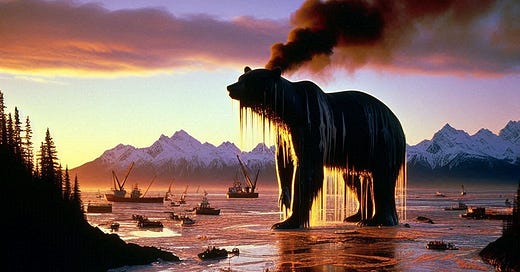The Mysteries of History (March 24 Edition)
Elvis in the Army; Teach-In; Exxon Valdez Oil Spill; Arkansas School Shooting; Suicidal Mass Murderer Co-Pilot
1958 — Elvis Leaves the Plough Behind
public domain image from wikimedia commons
On this date in 1958, while his son “Heartbreak Hotel” was tearing up the airwaves, Elvis Presley was inducted into the U.S. Army as a private. He had already had two draft deferments prior to that: the first time in 1953, because he was in enrolled in High School and was in good standing there, and the second time in 1957, because he was filming a movie at the time (King Creole). In 1958, he was no longer in school nor in the middle of shooting a movie, so he got called up then. Elvis was 23 years old at the time. While stationed in Germany, Elvis met his future wife, Priscilla Beaulieu (who was 14 at the time they met).
Questions: When did Elvis and Priscilla get married? How long were they married? What did Elvis do while he was in the Army?
1965 — First Teach-In Protesting the Vietnam War
public domain image from wikimedia commons
Two hundred faculty members at the University of Michigan in Ann Arbor teamed up to present a series of anti-war seminars on this date in 1965. It was the first “teach-in.” The regular classes were canceled and replaced with rallies and speeches. This started a trend; soon, Universities throughout the Country were sponsoring their own “teach-ins.”
Questions: Why was their so much anti-war sentiment in 1965? Did the police intervene? How many students protested the protests? How many parents of the students protested the protests, and how many supported the “teach-ins”? What was the effect of them?
1989 — Exxon Valdez Ecological Disaster
public domain image from wikimedia commons
The following is what I wrote about The Exxon Valdez Oil Spill in my book Still Casting Shadows: A Shared Mosaic of U.S. History — Volume 2: 1914-2006:
“We are vandals of the earth. We are destroying everything we inherited.”—Jacques Cousteau
“Some people say the animals see the straight path and flee from it in fear, for they know it was built by men.”—James Houston
“For the President to call for oil drilling in the Arctic Wildlife Refuge is like burning the furniture in the White House to keep the first family comfortable.”—Gaylord Nelson, founder of Earth Day
The Alaska Pipeline carries oil from the Prudhoe Bay fields way in the northern part of this more-than-twice-as-big-as-Texas State down south to Valdez on the Gulf of Alaska, the northernmost year-round ice-free port. The tiny town of Valdez, eight-hundred miles south of Prudhoe Bay, is thus a busy place, where supertankers fill up with crude and carry it on to other ports of call. At least, that’s what’s supposed to happen. On March 24th of this year, much of the oil the Exxon Valdez was carrying spilled out into Prince William Sound: Over one-fifth of its load, or 11 million gallons of it, in fact. Straying a mile-and-a-half off course, the gargantuan supertanker (the Exxon Valdez was 987 feet long, which is almost as long as the Sears Building is tall, and whose helmsman stands one fourth of a mile behind the ship’s massive prow) struck ground, ripping, Titanic-like, gaping holes in its hull. How could an experienced captain allow this to happen, you wonder? An unlicensed third man was in command at the time. And why was that? Crew reductions, made in order to reduce operating costs (read: put more money in shareholders’ pockets) led to mariners working longer hours and performing additional duties. The third mate may not have been fully qualified to serve as commander. In any case, he had been up since early the previous day when the accident occurred shortly after midnight. As bad as the spill was, it could have been worse. Deep-sea divers sent out to inspect the damage reported that the ship was teetering on the edge of Bligh Reef. The abyss yawning below the ship was several hundred feet deep. If the ship shifted with the tide, the entire ship could go down. If it broke apart on hitting the bottom, the other 42 million galls of oil could have also been released into the biosphere. As horrible as an 11 million gallon oil spill was—negatively impacting the livelihood of scores of fishermen in Valdez, and killing thousands of birds and sea mammals—it is actually as a drop in the bucket when compared to the two million tons of oil belched into the sea each and every year by supertankers. And yet there is an even worse culprit when it comes to spilling oil, thereby polluting the environment: According to Consumer Reports, people who personally change their automobile’s engine oil discard between 200 million and 400 million gallons of waste oil every year. It is estimated that only 10 to 14 percent of that oil is properly disposed of. The one-tenth to one-seventh of the waste oil that is properly disposed of gets recycled, but what about the other 86–90%? Apparently, it is simply being dumping indiscriminately. Thus millions of gallons of waste oil end up in the ground, in streams, or in sewers each year. It would take at least 25 Exxon Valdez-sized spills annually to equal that amount of despoliation. How bad a problem is it? Consumer Reports noted that if the oil gets “into drinking water, there can be serious conse quences: One gallon of used oil can make a million gallons of fresh water undrinkable, and a mere pint of oil can produce a slick that covers an acre [0.4 ha] of water.
The spill ended up polluting 700 miles of coastline. How could such a disaster occur. The captain, Joseph Hazelwood, was drinking at the time of the accident. The person doing the steering of the vessel was not certified to do so. Hazelwood was convicted for his role in the accident. His punishment was a $50,000 fine and 1,000 hours of community service (approximately six months of full-time work). His conviction was later overturned, though, because of a law that stipulates that a person who reports an oil spill is immune from prosecution.
Mega corporation Exxon also got off easy. At first, they were fined $100 million and obligated to pay ten times that ($10 billion over the next ten years) to cover the cost of cleanup. After the uproar had died down (after some time had passed), both the State of Alaska and Exxon quietly cut that $10,100,000,000 down to a measly $25 million (chump change for Exxon), which was far less than they had originally agreed to and far, far less than what the cost to clean up their mess was.
Sometimes it’s a case of “The bigger they are, the softer they fall.”
Questions: How much money did Exxon make in 1989? How much did they have in their coffers at the time they paid out the $25 million (assuming they ever really did)?
1998 — Westside Middle School Shooting
public domain image from wikimedia commons
A pre-teen and a barely-teenage pair shot up Westside Middle School near Jonesboro, Arkansas, on this day in 1998. They were eleven and thirteen years old. The two boys set off a fire alarm in order to lure the students and teachers out of the school, and then shot at them from afar, killing four fellow students and a teacher, and wounding ten other students (including a cousin of the younger shooter).
Confusion reigned at first as the boys opened fire, as someone yelled, “It’s all fake!” and others thought the sounds they were hearing came from nearby construction activity or firecrackers that had been set off to cause the students to take the fire drill more seriously.
Shannon Wright, the sole teacher to die, did so while using her body as a shield to protect a wounded student. All who died were female: the 32-year-old teacher, two 11-year-old girls, and two 12-year-old girls.
The perpetrators had thirteen firearms in their possession when apprehended, as well as a crossbow and knives stashed in the van they had stolen.
Arkansas law at the time only allowed minors to be kept in custody until the age of 21, so one of them was released in 2005, but re-offended and was re-incarcerated. The younger one (who was in custody longer because it took him two more years to reach the age of 21 than the older one) died in a car crash in 2019, twelve years after being released.
Questions: When a person has had a troubled childhood (such as being sexually abused), should this affect the punishment meted out to them? In such a case, should the causers of the harm (in this case, the sexual molesters) be considered complicit or accomplices in the crimes committed by their victim? How old would the shooting victims be if they were alive today?
2015 — Suicidal Co-Pilot Kills 150
public domain image from wikimedia commons
Exactly a decade ago today, a German airliner crashed into the French Alps. It was not an accident. The co-pilot deliberately took 149 lives along with his own. When the pilot left the cockpit for a break, he asked the co-pilot to take over flying duties. Four minutes later, the plane entered a steep descent; ten minutes after that, the plane violently contacted the mountains at 435 mph near the French town of Prads-Haute-Bleone. The impact of the crash was so catastrophic that the victims were buried together in a mass grave, as none of them could be identified.
Investigators determined that after the pilot left the cockpit, the co-pilot locked him out. They knew this because the recording on the plane’s “black box” revealed the pilot yelling at the co-pilot to open the door and his futile attempts to batter down the door. Ironically, 9/11 may have indirectly contributed to the co-pilot’s mass murder, as fortified cockpit doors had been installed to prevent people from breaking into the cockpit.
The investigation also turned up evidence of the co-pilot having a history of severe depression and recently searching the internet for ideas on how to die by suicide and cockpit security.
The co-pilot reportedly had been found unfit to continue working, but kept these findings from his employer.
Eighteen different Countries from all over the world were represented among the 150 who died, but the majority of them were from Germany (72) and Spain (51).
Questions: If it’s true that the co-pilot was found unfit for duty, why would the ones who came to that conclusion not report it directly to his employers, rather than keep it to themselves and hope or assume that the co-pilot would self-report? Were any of the crew or passengers able to make phone calls or send texts during the descent of the aircraft?
Read about “The Secret Lives of Kids” here.











